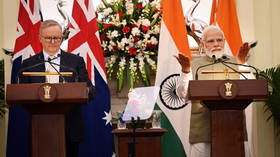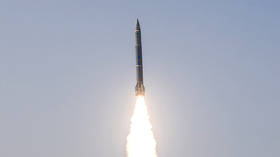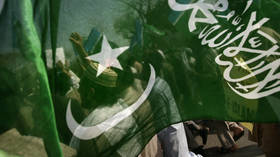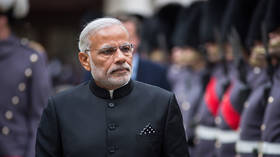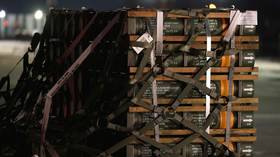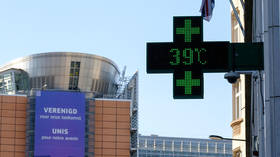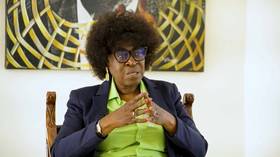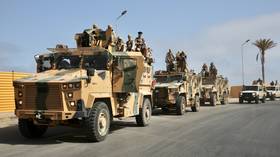India vs. the media: How Modi became a darling of the domestic press and a pariah for Western journalists
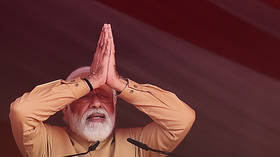
The New York Times has fired a fresh salvo at India’s right-wing government, led by Prime Minister Narendra Modi, for its muscular Hindutva policies aimed at neutralizing Islamist separatists in the troubled Jammu and Kashmir (J&K) region.
The US outlet, which has found itself at odds with the Modi administration since it came to power in 2014, mounted a fresh two-pronged attack with two articles on March 8. In doing so, it provoked stinging rebukes from the Indian government.
The NYT’s accusations
In an opinion piece, Anuradha Bhasin, the executive editor of The Kashmir Times, hit out at the Modi administration for gagging press freedom in J&K. “His repressive media policies are destroying Kashmiri journalism, intimidating media outlets into serving as government mouthpieces and creating an information vacuum in our region of about 13 million people,” Bhasin wrote.
Bhasin’s trenchant criticism stemmed from the Indian government’s draft rules that would require global social media platforms such as Twitter and Meta to remove any post that is tagged as ‘fake news’ by the Modi administration’s information dissemination wing, the Press Information Bureau (PIB). Critics believe that the new rules, proposed in January as an amendment to the Information Technology (Intermediary Guidelines and Digital Media Ethics Code) Rules, 2021, are a threat to objective news reporting and free speech on the internet.
It is feared that the PIB will be influenced by political concerns in its tagging of ‘fake news’. Past precedents do show that the PIB’s fact-checking arm has placed its ‘fake news’ stamp on materials critical of the government.
Bhasin’s piece rang a cautionary bell, as she alleged that J&K was being used as a laboratory for experimentation before the amended law was rolled out in the rest of the country. “In other words, the rest of India may end up looking a lot like Kashmir,” she adds.
The other piece was an on-the-ground report from a Hindu-dominated village in Jammu that describes how Modi’s regime has been arming a homegrown militia in an effort to thwart the lethal Islamist militant attacks that target the Hindu minority. The article implies that the arming of the Hindus, whose causes the Modi regime seeks to champion, is evidence that there’s a chink in the armor of the Indian security forces. An estimated 350,0000 security personnel, including over 100,000 from the Indian Army, have been deployed in J&K since the insurgency reared its ugly head in 1989 – and the fact that the government “has felt compelled to arm thousands of civilians in one of the world’s most militarized places shows the limits of Prime Minister Narendra Modi’s more muscular approach to controlling the long-restive region,” the article says.
The militia is drawn from a motley crew of working-class Hindu civilians, including “drivers, shopkeepers and farmers,” who have been victims of Muslim-majority violence in the past. However, the NYT report says that the Muslim majority, some of whom have also been victims of senseless violence, have not received the same kind of support from the Modi government.
The Indian government’s response
India’s federal minister for information and broadcasting, Anurag Thakur, took exception to the opinion piece and dubbed it “mischievous and fictitious.” He claimed that the American publication has ceased to be neutral since the Hindu nationalist Modi administration came to power in 2014.
“NYT’s so-called opinion piece on freedom of press in Kashmir is mischievous and fictitious, published with a sole motive to spread propaganda about India and its democratic institutions and values,” Thakur tweeted, accusing foreign media in general of “spreading lies about India and our democratically elected PM Modi.”
“Freedom of press in India is as sacrosanct as other fundamental rights (as enshrined in the Constitution),” he said, adding that people in India “are very mature and we don’t need to learn grammar of democracy from such agenda-driven media. Blatant lies spread by NYT about press freedom in Kashmir are condemnable.”
The Modi government’s J&K policy
India has been engaged in a proxy war in J&K – “one of the most militarized places on earth,” according to the NYT – for over three decades.
J&K shares a 1,222-kilometer-long border with India’s arch-rival and nuclear-power neighbor Pakistan with which New Delhi has successfully fought three wars. The J&K frontier is divided into two parts – the international border and the Line of Control – the latter being where a ceasefire agreement was initially signed in 2003. It has been in force sporadically since. India accuses Islamabad of fomenting separatism in J&K, which the Islamic republic claims as an integral part of its territory since the Partition in 1947.
J&K enjoyed a semi-autonomous status as a state until 2019, when the government revoked it. After Modi’s right-wing Bharatiya Janata Party (BJP) swept to power in 2014, the party reiterated its intention to repeal Article 370 of the Indian constitution – a special citizenship law that protected the jobs and land rights of local residents in J&K. In the 2019 parliamentary polls, the BJP had made revoking the law one of the primary promises of its election manifesto. The Modi government lived up to that promise within months of being re-elected.
J&K was stripped of its partial autonomy – a privilege it had enjoyed for decades – and divided into two federal territories: the eponymous Jammu and Kashmir and Ladakh. The territories were also brought under New Delhi’s direct federal control. Soon, a new domicile law was introduced that allowed non-Kashmiris to settle in the newly carved out territory, which raised fears of a demographic change in the volatile Muslim-majority region.
The implementation of the new law coincided with the Modi regime deploying more boots on the ground – under the Armed Forces (Jammu and Kashmir) Special Powers Act in place since 1990 – followed by a massive crackdown on dissenting voices.
J&K’s claim to self-determination and its affinity with neighboring Pakistan stems from its Islamic religious identity. According to the 2011 census, the population of J&K was 68.31% Muslim and 28.43% Hindu. The Kashmir Valley – perceived to be the hotbed of Islamist militancy – was 96% Muslim.
Insurgency quelled?
The insurgency has largely been contained in J&K since the abrogation of its special status. “More terrorists are dying now and fewer civilians are being killed,” India’s federal home minister, Amit Shah, said in early January. Data from Indian reports support the minister’s claims, although the figures have been questioned by international human rights bodies.
In 2019, security forces estimated that 250 militants were active in the Kashmir Valley, a number that had come down to a “little over 100” by the end of last year. In the last four years, around 750 militants have been killed, of which 83% were Kashmiris. However, recent trends suggest that more foreign militants (meaning Pakistani non-state actors) are infiltrating through the Line of Control. Of the total militants killed last year, 43% were foreigners.
Government data has enumerated that though 143 Kashmiri youth joined the insurgency in 2019, the corresponding figure for last year was 100. In 2022, 65 newly recruited militants were eliminated and another 17 were arrested. The remaining 18 are still believed to be active.
The number of civilian casualties has similarly been on the decline. Last year, 29 were killed, compared to 44 the previous year. The minority Kashmiri Pandits, whose exodus numbering over 100,000 started in the early days of the insurgency in the valley in 1989-90, have been consistently targeted by the militants.
Altogether, 26 members of minority communities and migrant laborers from 15 other Indian states have been killed since 2019. A total of 215 security personnel, including 60 belonging to the J&K police, have also lost their lives since 2019.
The revocation of J&K’s semi-autonomous status also led to a steady decline in law-and-order disturbances, which plummeted from 584 incidents in 2019 to 26 last year. The insurgency was largely quelled following the invocation of anti-terror legislation such as the ‘draconian’ Unlawful Activities Prevention Act (UAPA), under which 650 people were detained last year.
However, International human rights bodies have been critical of the Indian government’s strong-arm response to the J&K insurgency. For instance, a report released by Amnesty International last September offered a damning indictment of the Modi administration, stating: “The Indian government has drastically intensified the repression of rights in J&K in the three years since the change in status of the region.”
The government has taken umbrage at such reports and touted an unprecedented surge in tourism as a growing indication of normalcy being restored in the troubled region. According to the government’s latest figures, 120,000 visitors arrived in Kashmir last month. Last year, a record 2.5 million visitors, an unprecedented number in the past four decades, braved the threat of violence and traveled to Kashmir. Such numbers provide a massive impetus to the tourism industry in the valley.
Past run-ins with the NYT
The Modi administration has run afoul of the NYT before, such as in a piece published last year titled ‘The New India: Expanding Influence Abroad, Straining Democracy at Home’. “It is India’s credentials as the world’s largest democracy that Mr. Modi rides on the global stage. But at home, diplomats, analysts, and activists say, Mr. Modi’s government is undertaking a project to remake India’s democracy unlike any in its 75 years of independence – stifling dissent, sidelining civilian institutions and making minorities second-class citizens,” the piece said, provoking an angry response from Indian Minister of External Affairs Subrahmanyam Jaishankar, who accused the newspaper of biased coverage.
Similarly, another controversy erupted after the NYT reported that India had bought the Israeli spyware Pegasus in 2017 as part of a $2 billion defense package to snoop on critics of Modi. In April 2022, the publication again stirred a hornet’s nest over India’s reluctance to make its Covid-19 death toll public, suggesting that the actual casualty count was far higher than initially estimated. The report claimed that an ambitious effort by the World Health Organization (WHO) showed that more than 15 million people died globally due to the pandemic.
“More than a third of the additional nine million deaths are estimated to have occurred in India, where the Modi government has stood by its own count of about 520,000.” However, the NYT’s claims based on the WHO data were debunked by the Indian government as having used flawed methodology.
Domestic media tamed, foreign media next?
A vast section of the domestic media has been in awe of the Modi regime and has capitulated under its “authoritarian rule,” according to the shrinking group of liberal publications, which have kept up their resistance up despite their meager resources and limited reach.
The PM, who has belittled the importance of media and prefers communicating directly with the masses through his weekly radio show Mann ki Baat, which loosely translates as Point of View, or via Twitter, has not held a single press conference since assuming power nine years ago. His 86.9 million followers on Twitter make him one of the most popular leaders on social media. Perhaps this mass appeal explains his lack of interest in media attention.
India’s domestic media has fallen in line and remains among Modi’s most ardent cheerleaders. It’s a redux of India’s 22-month emergency rule during Indira Gandhi’s tenure between 1975 and 1977, when the Indian media were famously said to have “crawled when they were only asked to bend.” The PM has used the domestic media to stellar effect to amplify his thoughts and deeds, which many journalists are happy to do while forgoing the expected tasks of asking questions and demanding accountability, likely for fear of reprisal.
A Western media bias or a changing India?
India’s place at the global table has changed irrevocably since 1991, when the economic liberalization began, giving Western powers access to one of the biggest markets in the world. It was a different era back then – one in which India’s politicians and intelligentsia did not worry themselves silly over how the Western media portrayed the nation, which was on the cusp of momentous socio-economic change. The Western media’s utterances were at times far removed from reality due to its sheer ignorance of a country as complex as India. And they were no longer considered the gospel truth. Self-belief gradually blossomed as India’s economic boom became a global talking point.
Unlike the domestic press, however, the foreign media is under no obligation to be under the government’s thumb. The latest fracas with the BBC is a case in point. To make matters worse, the Modi regime has made it increasingly difficult for foreign journalists to cover India objectively.
Newslaundry.com, a private media watchdog that was founded in 2012, before Modi came to power, reported last month that “every second foreign correspondent has been summoned by the government to explain their reportage critical of ministries. Since August 2019, almost no one has been allowed to visit J&K and report independently there. And journalists who write ‘negative stories’ are given visas valid for less than a year, putting their jobs at stake.”
As the PM is being slammed for going after the foreign media after silencing critics back home, some of the bad press that he has received defies belief – Modi’s India has been compared to Nazi Germany and called a place where tyranny is winning against ‘global democracy’, among other assertions. And if the current trend persists, Modi may continue to be the darling of the Indian masses, but a pariah to foreign media.
This may not be such a bad deal for him, however, both at home – where he is eyeing a third consecutive term as PM next year – and abroad, where world leaders are keen to remain India’s partners to retain access to its huge market and geostrategic opportunities, even as various pro-democracy NGOs downgrade India to various levels of ‘non-free’ or ‘autocratic’ status.
But before the Western media versus Indian nationalism debate sparks off a raging debate on the country’s TV channels that go to war with Pakistan and China every other evening to stay afloat in the cut-throat ratings business, it’s high time to step back and ponder: who has changed since the Modi regime came to power? Has the country’s social fabric changed from the pre-Modi era or is it that the Western media has been serving ‘manufactured’ news and views? The truth is likely somewhere in between. And there is no easy answer in the prevailing debate.
The statements, views and opinions expressed in this column are solely those of the author and do not necessarily represent those of RT.
